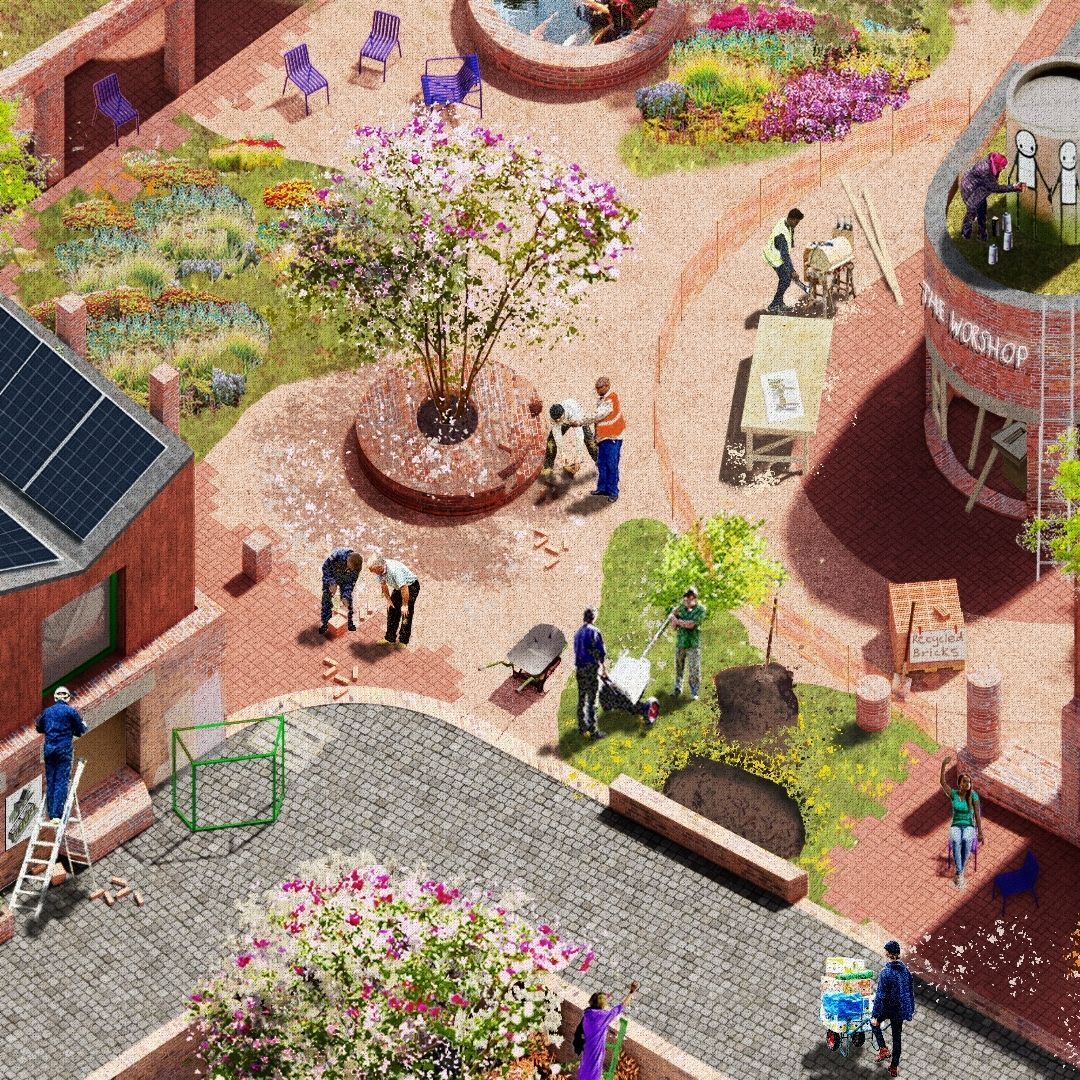Get updates from The Developer straight to your inbox Yes, please!
Helping Hands, Liverpool, for the Independence Initiative and Neighbourhood, with Studio MUTT

Helping Hands responds to the urgent need for temporary homeless accommodation in Bootle. The project proposes the use of a 2ha site adjacent to Hugh Baird College in Liverpool and incorporates both shared accommodation and individual homes. A repeated garden wall would identify the Helping Hands site as a development that builds on existing community infrastructure, improving small scale social and civic areas.
Who is on the project team? (designer, consultants, etc)
Studio MUTT, Neighbourhood, Hugh Baird College, Islington Hostel Outreach, Amber Akaunu, Peter O’Neil, and Dead Good Poets Society
Describe the context of this project, its neighbourhood and people.
Helping Hands is a proposal for a co-created masterplan, designed as a submission to the 2023 Davidson Prize, which called for ideas to tackle the nationwide problem of homelessness. It was announced winner in June 2023, less than six months before a call was made by Liverpool’s council to the UK government for help with the city’s spiralling homelessness crisis. The project is based in Bootle, Liverpool – one of the poorest UK regions until the early noughties following post-war decline, with historically high levels of unemployment. Helping Hands is designed for an existing site, envisioning a nurturing communal landscape co-created by residents, neighbours and support organisations. The site is taken from leftover spaces of a typical urban block adjacent to Hugh Baird College, and already hosts several expert organisations that help homeless and vulnerable people. The proposal opens and connects the ‘backs’ of these organisations, reorienting them within a shared, versatile space. Helping Hands does not approach the problem of homelessness with a wholesale solution. It takes an iterative approach, acknowledging the different phases and facets of what might bring someone to live on the streets. The UK’s National Audit Office suggests that a third of young people leaving care experience homelessness within two years. Recent studies also found that 41% of care leavers were not in education, employment or training, compared to 15% of all 19-year-olds. Helping Hands seeks to connect these issues and facilitate an infrastructure to help care leavers transition to independent living and meaningful employment.
Please describe your approach to this future place and its mix of uses. How will it function as a vibrant place?
The Helping Hands project was conceived with a clear aim to deconstruct the problem of homelessness. Its focus fell on how architecture could help fix this urban issue beyond the obvious act of designing shelter. The project’s strategy became to activate what already existed on its chosen site in Bootle to address developing user needs, all the while retaining identity of place and a sense of community ownership. The proposal coalesces community spaces to the centre of the site, with a band of housing encircling areas for group gathering, treatment, and social activity. In this way, the design ensures residents are not jettisoned to an isolated area, which would reinforce feelings of loneliness. A strip of communal workshops at the rear of the site activates what might conventionally degenerate into dead space, enlivening the entirety of the masterplan whilst creating a passive sense of security. Its ‘Potting Shed’ is proposed as a communal space for flexible use – an amenity for independent study, work, or therapy. This and other shared spaces within the masterplan provide support for self-sustenance, food-production, and gardening, the goal being to uplift residents’ wellbeing by creating a palpable sense of control. The team recognised how the curation of space on site could link up with existing neighbourhood welfare services, responding to the faceted issue of post-care housing provision in a holistic, connected way. Aside from the baseline offering of temporary accommodation, the proposal looks at opportunities to build autonomy into the fabric of the site.
What is the environmental impact of the project? How will the carbon use and material impact of the development be mitigated? What is the sustainability strategy?
The central design strategy for Helping Hands is to re-appropriate existing space for developing uses. By nature, the project promotes reusability on a site-wide level, encouraging both material and functional circularity. Existing structures are reused and retrofitted where possible, integrated as part of the scheme to implement areas of backland which may usually be overlooked. The workshop which is developed as a later part of the project reuses an existing brick garage - opening it out to the main pathway and becoming a central hub for both learning and construction. Within its building scope, Helping Hands proposes construction training for residents and site-users. This will support upskilling and promote future labour, but will also limit the ‘delivery footprint’ by encouraging local, small-scale development. The project’s emphasis on green space promotes biodiversity uptake and the creation of on-site food production – decreasing the masterplan’s food-related carbon footprint. Where new builds are proposed, both timber frame construction and cladding are used as their main material component, allowing for an overall lower embodied carbon impact to the environment. The design of each of the homes inclusive of footprint are curated in a way in which provides optimum space for users, building smaller yet more crafted spaces for its inhabitants. The roof is designed to optimise solar power as a renewable energy source for each of the homes, helping to offset the long term carbon footprint of the scheme.
Sign up to our newsletter
Get updates from The Developer straight to your inbox
Thanks to our organisation members
© Festival of Place - Tweak Ltd., 124 City Road, London, EC1V 2NX. Tel: 020 3326 7238